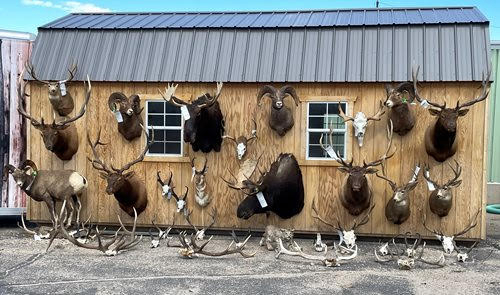Calling Mature Bucks
by Todd Amenrud
 Whitetails vocalize to communicate a variety of socially important information… well, important to a whitetail anyhow. Their sounds vary in pitch and intensity and just a slight change in either can give the sound a different meaning. Most importantly, I know they can be called to us by imitating these sounds. Aside from a doe and her young fawns during the spring, whitetails are most vocal during the fall months and breeding season. Making the right sound at the right time can be an exciting way to fill a tag and put a trophy on the wall.
Whitetails vocalize to communicate a variety of socially important information… well, important to a whitetail anyhow. Their sounds vary in pitch and intensity and just a slight change in either can give the sound a different meaning. Most importantly, I know they can be called to us by imitating these sounds. Aside from a doe and her young fawns during the spring, whitetails are most vocal during the fall months and breeding season. Making the right sound at the right time can be an exciting way to fill a tag and put a trophy on the wall.
A whitetail’s sense of hearing is what we’re trying to reach when using a call so we need to understand a few things about it. The average hunter would say that a whitetail has much better hearing than a human. Actually, our ear drum is more sophisticated. Humans have the capabilities to pick up higher pitch and lower pitch frequencies, however, imagine if you had two huge, open-ended cones that you could direct and cup sound with. Because of the style of their ears a whitetail can distinguish and pinpoint the location of sounds much better.
As far as the often asked question, “how loud should I blow my call?” The short answer is, “make the sound the same volume that a real whitetail would.” Experience is the best teacher. Adult deer communicate through grunts, bleats, bawls, bellows, snorts, hisses and wheezes. The two most common sounds are grunts and bleats. Varying the tone, length or volume can give them totally different meanings. Both bucks and does make both grunts and bleats.
Two very common vocalizations are what some call the “contact bleat” and “attention grunt.” The contact bleat just simply means “here I am.” The attention takes it a step further and means “here I am, come to me” or, “come follow me.” Both of these sounds can be made on a number of blown through, adjustable O-ring type calls or bleat cans.
Possibly the most commonly heard vocalization during the breeding season is a “tending grunt.” This grunt sound differs from the attention grunt in that it sounds more nasal and smooth where the attention grunt is throaty and has a “clicking” nature. The tending grunt is made by bucks either when following an estrus doe, while he’s checking different does to see if they are in estrus, when following a trail made by an estrus doe or when trailing a doe during the chase phase of the rut. I’ve had very little luck calling deer to me with this sound.
Aggressive sounds like the “snort-wheeze” or “aggravated-grunt” will intimidate or alarm some deer. However, when it comes to mature bucks it can be just the ticket. I’ve used the aggravated-grunt, or what some call the “growl-grunt,” numerous times to call in mature bucks. This sound is a longer, drawn-out grunt that is phrased somewhat like a growl. It’s not as common as other whitetail vocalizations, yet I’ve heard it a number of times in the wild. It is common to hear before a confrontation between two mature bucks. Their hair gets bristled up, they do a funny looking stiff-legged walk and posture each other side to side trying to intimidate their opponent. It is often made in combination with other aggressive sounds and basically means “I’m king of the hill, hit the trail buddy!”
The “Buck Roar” from Primos is a call that is designed specifically for aggressive buck sounds. This call was initially intended to do another unique buck vocalization dubbed the “roar” but will work to do several different buck calls. Some may have heard this “roar” sound and not known it was a deer making it. I would have to describe it as almost like a buck “bark.” Even though this is an aggressive sound, you will be amazed at how well bucks are drawn to it.
Another vocalization that I’ve also had success using is a “breeding bellow.” The breeding bellow is made by an estrus doe when she is ready to breed and should not be confused with an “estrus bleat.” I’ve only heard this hair-raising vocalization several times in the wild but I’ve listened to it being made by captive does many times. Although I hear this most often with captive does, it has worked for me numerous times in the wild. It’s an urgent sound that resembles a long sheep baa. It basically means “hey baby, I’m over here and I’M READY NOW!” You can make this sound on several calls. A bleat-can will work but it doesn’t quite capture the volume, pitch fluctuation or tone of the real deal. Years ago I used to sit in my buddy’s deer pens and listen to the does make this breeding bellow and then try to repeat it. I can actually make it best with my own voice.
There’s also a very social buck call some refer to as a “buck bawl.” This is not a distress bawl, this call I believe is basically a “buck bleat.” Some call it a bawl probably because it is louder than a typical social bleat. It sounds more like the noise should be coming from a sheep than a whitetail. Late season is the only time I’ve had this call work for me.
More often than vocally, whitetails communicate through odors or body language. In fact, a key to becoming good at calling deer is learning to understand or “read” body language. You need to know whether or not you’ve blown the right call, whether you should change calls or try again. Watch their body posture, their tail positions and movements and their overall demeanor to tell if you’ve “hit a nerve.” Watch their ears, if their ears are still searching you probably need to blow the call again and possibly a little louder. When their ears lock in on your position, stop calling. Your call has been heard, and the “kiss of death” can be over-calling.
Use other stimuli in conjunction with calling. Use rattling, scent, or decoys in combination. Almost always a mature buck will swing downwind and scent-check the area where the sound came from before he closes the distance. He’s heard “deer sounds” (your calling), now if he swings downwind and smells “deer smells” (some scent) it appeases another sense and makes the situation seem real. Now what if he swings downwind and satisfies his sense of smell but also sees another deer (your decoy)…get the picture? The more senses you appease the more the condition seems real.
Match the scent to the situation – for instance, if you’re making an estrus bleat close to the rut, a little Special Golden Estrus placed out crosswind from your location can help seal the deal. Or, if it’s early season and you are making soft, social buck grunts, a plain buck urine or curiosity scent like Trail’s End #307 will help you to score.
Keep your ears open and listen to them communicate for yourself. There is no doubt, a whitetail is a social animal, and calls are one tool we can use to get closer to them.






